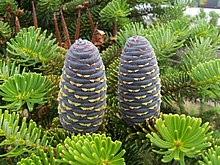Fir wood
| Fir Temporal range: 49–0 Ma |
|
|---|---|
 |
|
| Korean fir (Abies koreana) cones and foliage | |
| Scientific classification | |
| Kingdom: | Plantae |
| Division: | Pinophyta |
| Class: | Pinopsida |
| Order: | Pinales |
| Family: | Pinaceae |
| Subfamily: | Abietoideae |
| Genus: |
Abies Mill. |
| Species | |
|
See text |
|
See text
Firs (Abies) are a genus of 48–56 species of evergreen coniferous trees in the family Pinaceae. They are found through much of North and Central America, Europe, Asia, and North Africa, occurring in mountains over most of the range. Firs are most closely related to the genus Cedrus (cedar). Douglas firs are not true firs, being of the genus Pseudotsuga.
They are large trees, reaching heights of 10–80 m (33–262 ft) tall with trunk diameters of 0.5–4 m (1 ft 8 in–13 ft 1 in) when mature. Firs can be distinguished from other members of the pine family by the unique attachment of their needle-like leaves and by their different cones.
Identification of the different species is based on the size and arrangement of the leaves, the size and shape of the cones, and whether the bract scales of the cones are long and exserted, or short and hidden inside the cone.
A. alba – the underside of leaves with 2 whitish strips formed by wax-covered stomatal bands
A. grandis foliage – upper side of the leaves
Atypical A. alba foliage from Dinaric calcareous fir forests on Mt. Orjen
Firs can be distinguished from other members of the pine family by the unique attachment of their needle-like leaves to the twig by a base that resembles a small suction cup.
...
Wikipedia
